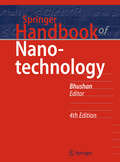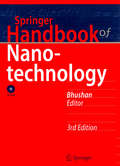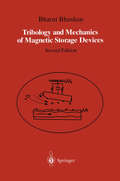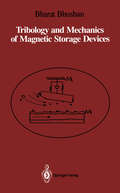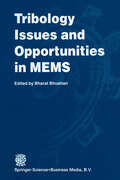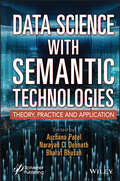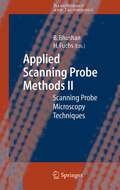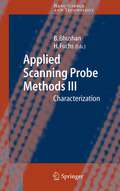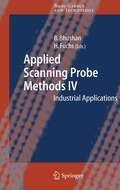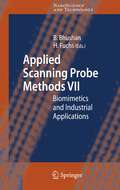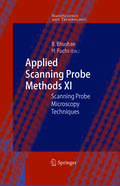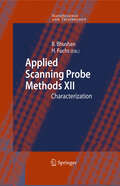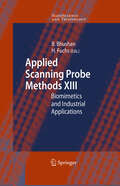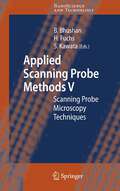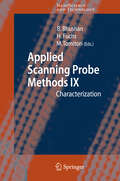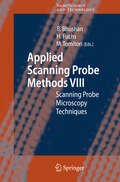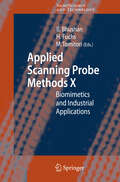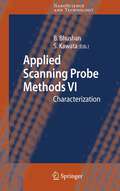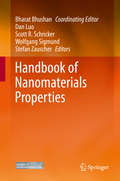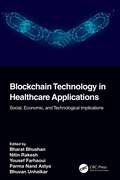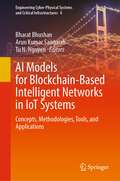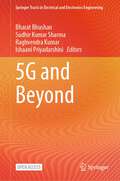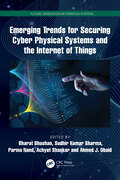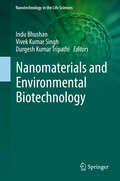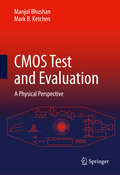- Table View
- List View
Springer Handbook of Nanotechnology (Springer Handbooks)
by Bharat BhushanThis comprehensive handbook has become the definitive reference work in the field of nanoscience and nanotechnology, and this 4th edition incorporates a number of recent new developments. It integrates nanofabrication, nanomaterials, nanodevices, nanomechanics, nanotribology, materials science, and reliability engineering knowledge in just one volume. Furthermore, it discusses various nanostructures; micro/nanofabrication; micro/nanodevices and biomicro/nanodevices, as well as scanning probe microscopy; nanotribology and nanomechanics; molecularly thick films; industrial applications and nanodevice reliability; societal, environmental, health and safety issues; and nanotechnology education. In this new edition, written by an international team of over 140 distinguished experts and put together by an experienced editor with a comprehensive understanding of the field, almost all the chapters are either new or substantially revised and expanded, with new topics of interest added. It is an essential resource for anyone working in the rapidly evolving field of key technology, including mechanical and electrical engineers, materials scientists, physicists, and chemists.
Springer Handbook of Nanotechnology (Springer Handbooks)
by Bharat BhushanSince 2004 and with the 2nd edition in 2006, the Springer Handbook of Nanotechnology has established itself as the definitive reference in the nanoscience and nanotechnology area. It integrates the knowledge from nanofabrication, nanodevices, nanomechanics, Nanotribology, materials science, and reliability engineering in just one volume. Beside the presentation of nanostructures, micro/nanofabrication, and micro/nanodevices, special emphasis is on scanning probe microscopy, nanotribology and nanomechanics, molecularly thick films, industrial applications and microdevice reliability, and on social aspects. In its 3rd edition, the book grew from 8 to 9 parts now including a part with chapters on biomimetics. More information is added to such fields as bionanotechnology, nanorobotics, and (bio)MEMS/NEMS, bio/nanotribology and bio/nanomechanics. The book is organized by an experienced editor with a universal knowledge and written by an international team of over 150 distinguished experts. It addresses mechanical and electrical engineers, materials scientists, physicists and chemists who work either in the nano area or in a field that is or will be influenced by this new key technology.
Tribology and Mechanics of Magnetic Storage Devices
by Bharat BhushanSince January 1990, when the first edition ofthis first-of-a-kind book appeared, there has been much experimental and theoretical progress in the multi disciplinary subject of tribology and mechanics of magnetic storage devices. The subject has matured into a rigorous discipline, and many university tribology and mechanics courses now routinely contain material on magnetic storage devices. The major growth in the subject has been on the micro- and nanoscale aspects of tribology and mechanics. Today, most large magnetic storage industries use atomic force microscopes to image the magnetic storage components. Many companies use variations of AFMs such as friction force microscopes (FFMs) for frictional studies. These instruments have also been used for studying scratch, wear, and indentation. These studies are valuable in the fundamental understanding of interfacial phenomena. In the second edition, I have added a new chapter, Chapter 11, on micro and nanoscale aspects of tribology and mechanics of magnetic storage compo nents. This chapter presents the state of the art of the micro/nanotribology and micro/nanomechanics of magnetic storage components. In addition, typographical errors in Chapters 1 to 10 and the appendixes have been corrected. These additions update this book and make it more valuable to researchers of the subject. I am grateful to many colleagues and particularly to my students, whose work is reported in Chapter 11. I thank my wife, Sudha, who has been forbearing during the progress of the research reported in this chapter.
Tribology and Mechanics of Magnetic Storage Devices
by Bharat BhushanMagnetic recording is presently a $50 billion industry. It spans audio, video, and digi tal applications in the form of tapes and disks. The industry is expected to grow by a factor of five or more in the next decade. This growth will be accompanied by dramatic improvements in the technology, and the potential exists for magnetic-recording den sities to improve by at least one order of magnitude! Magnetic-recording process is accomplished by relative motion between a mag netic head and a magnetic medium. Types of magnetic media for digital recording are: flexible media (tapes and floppy disks) and rigid disks. Physical contact between head and medium occurs during starts and stops and hydrodynamic air film develops at high speeds. Hying heights (mean separation between head and medium) are on the order of 0. 1 micrometer comparable to surface roughness of the mating members. Need for higher and higher recording densities requires that surfaces be as smooth as possible and flying heights be as low as possible. Smoother surfaces lead to increased static/ kinetic friction and wear. In the case of magnetic tapes, in order to have high bit capac ity for a given size of a spool, we like to use as thin a tape substrate as possible. Thinner tapes are prone to local or bulk viscoelastic deformation during storage. This may lead to variations in head-tape separations resulting in problems in data reliability.
Tribology Issues and Opportunities in MEMS: Proceedings of the NSF/AFOSR/ASME Workshop on Tribology Issues and Opportunities in MEMS held in Columbus, Ohio, U.S.A., 9–11 November 1997
by Bharat BhushanMicro Electro Mechanical Systems (MEMS) is already about a billion dollars a year industry and is growing rapidly. So far major emphasis has been placed on the fabrication processes for various devices. There are serious issues related to tribology, mechanics, surfacechemistry and materials science in the operationand manufacturingof many MEMS devices and these issues are preventing an even faster commercialization. Very little is understood about tribology and mechanical properties on micro- to nanoscales of the materials used in the construction of MEMS devices. The MEMS community needs to be exposed to the state-of-the-artoftribology and vice versa. Fundamental understanding of friction/stiction, wear and the role of surface contamination and environmental debris in micro devices is required. There are significantadhesion, friction and wear issues in manufacturing and actual use, facing the MEMS industry. Very little is understood about the tribology of bulk silicon and polysilicon films used in the construction ofthese microdevices. These issues are based on surface phenomenaand cannotbe scaled down linearly and these become increasingly important with the small size of the devices. Continuum theory breaks down in the analyses, e. g. in fluid flow of micro-scale devices. Mechanical properties ofpolysilicon and other films are not well characterized. Roughness optimization can help in tribological improvements. Monolayers of lubricants and other materials need to be developed for ultra-low friction and near zero wear. Hard coatings and ion implantation techniques hold promise.
Data Science with Semantic Technologies: Theory, Practice and Application (Advances in Intelligent and Scientific Computing)
by Bharat Bhushan Narayan C. Debnath Archana PatelDATA SCIENCE WITH SEMANTIC TECHNOLOGIES This book will serve as an important guide toward applications of data science with semantic technologies for the upcoming generation and thus becomes a unique resource for scholars, researchers, professionals, and practitioners in this field. To create intelligence in data science, it becomes necessary to utilize semantic technologies which allow machine-readable representation of data. This intelligence uniquely identifies and connects data with common business terms, and it also enables users to communicate with data. Instead of structuring the data, semantic technologies help users to understand the meaning of the data by using the concepts of semantics, ontology, OWL, linked data, and knowledge-graphs. These technologies help organizations to understand all the stored data, adding the value in it, and enabling insights that were not available before. As data is the most important asset for any organization, it is essential to apply semantic technologies in data science to fulfill the need of any organization. Data Science with Semantic Technologies provides a roadmap for the deployment of semantic technologies in the field of data science. Moreover, it highlights how data science enables the user to create intelligence through these technologies by exploring the opportunities and eradicating the challenges in the current and future time frame. In addition, this book provides answers to various questions like: Can semantic technologies be able to facilitate data science? Which type of data science problems can be tackled by semantic technologies? How can data scientists benefit from these technologies? What is knowledge data science? How does knowledge data science relate to other domains? What is the role of semantic technologies in data science? What is the current progress and future of data science with semantic technologies? Which types of problems require the immediate attention of researchers? Audience Researchers in the fields of data science, semantic technologies, artificial intelligence, big data, and other related domains, as well as industry professionals, software engineers/scientists, and project managers who are developing the software for data science. Students across the globe will get the basic and advanced knowledge on the current state and potential future of data science.
Applied Scanning Probe Methods II: Scanning Probe Microscopy Techniques (NanoScience and Technology)
by Bharat Bhushan Harald FuchsThe Nobel Prize of 1986 on Sc- ningTunnelingMicroscopysignaled a new era in imaging. The sc- ning probes emerged as a new - strument for imaging with a p- cision suf?cient to delineate single atoms. At ?rst there were two – the Scanning Tunneling Microscope, or STM, and the Atomic Force Mic- scope, or AFM. The STM relies on electrons tunneling between tip and sample whereas the AFM depends on the force acting on the tip when it was placed near the sample. These were quickly followed by the M- netic Force Microscope, MFM, and the Electrostatic Force Microscope, EFM. The MFM will image a single magnetic bit with features as small as 10nm. With the EFM one can monitor the charge of a single electron. Prof. Paul Hansma at Santa Barbara opened the door even wider when he was able to image biological objects in aqueous environments. At this point the sluice gates were opened and a multitude of different instruments appeared. There are signi?cant differences between the Scanning Probe Microscopes or SPM, and others such as the Scanning Electron Microscope or SEM. The probe microscopes do not require preparation of the sample and they operate in ambient atmosphere, whereas, the SEM must operate in a vacuum environment and the sample must be cross-sectioned to expose the proper surface. However, the SEM can record 3D image and movies, features that are not available with the scanning probes.
Applied Scanning Probe Methods III: Characterization (NanoScience and Technology)
by Bharat Bhushan Harald FuchsThe Nobel Prize of 1986 on Sc- ning Tunneling Microscopy sig- led a new era in imaging. The sc- ning probes emerged as a new i- trument for imaging with a pre- sion suf?cient to delineate single atoms. At ?rst there were two – the Scanning Tunneling Microscope, or STM, and the Atomic Force Mic- scope, or AFM. The STM relies on electrons tunneling between tip and sample whereas the AFM depends on the force acting on the tip when it was placed near the sample. These were quickly followed by the - gneticForceMicroscope,MFM,and the Electrostatic Force Microscope, EFM. The MFM will image a single magnetic bit with features as small as 10nm. With the EFM one can monitor the charge of a single electron. Prof. Paul Hansma at Santa Barbara opened the door even wider when he was able to image biological objects in aqueous environments. At this point the sluice gates were opened and a multitude of different instruments appeared. There are signi?cant differences between the Scanning Probe Microscopes or SPM, and others such as the Scanning Electron Microscope or SEM. The probe microscopes do not require preparation of the sample and they operate in ambient atmosphere, whereas, the SEM must operate in a vacuum environment and the sample must be cross-sectioned to expose the proper surface. However, the SEM can record 3D image and movies, features that are not available with the scanning probes.
Applied Scanning Probe Methods IV: Industrial Applications (NanoScience and Technology)
by Bharat Bhushan Harald FuchsApplied Scanning Probe Methods VII: Biomimetics and Industrial Applications (NanoScience and Technology)
by Bharat Bhushan Harald FuchsThe first volume in the series was released in January 2004 and the second to fourth volumes in early 2006. The field is now progressing so fast that there is a need for one volume every 12 to 18 months to capture latest developments. Volume VII presents 9 chapters on a variety of new and emerging techniques and refinements of SPM applications.
Applied Scanning Probe Methods XI: Scanning Probe Microscopy Techniques (NanoScience and Technology)
by Bharat Bhushan Harald FuchsApplied Scanning Probe Methods XII: Characterization (NanoScience and Technology)
by Bharat Bhushan Harald FuchsCrack initiation and growth are key issues when it comes to the mechanical reliab- ity of microelectronic devices and microelectromechanical systems (MEMS). Es- cially in organic electronics where exible substrates will play a major role these issues will become of utmost importance. It is therefore necessary to develop me- ods which in situ allow the experimental investigation of surface deformation and fracture processes in thin layers at a micro and nanometer scale. While scanning electron microscopy (SEM) might be used it is also associated with some major experimental drawbacks. First of all if polymers are investigated they usually have to be coated with a metal layer due to their commonly non-conductive nature. Additi- ally they might be damaged by the electron beam of the microscope or the vacuum might cause outgasing of solvents or evaporation of water and thus change material properties. Furthermore, for all kinds of materials a considerable amount of expe- mental effort is necessary to build a tensile testing machine that ts into the chamber. Therefore, a very promising alternative to SEM is based on the use of an atomic force microscope (AFM) to observe in situ surface deformation processes during straining of a specimen. First steps towards this goal were shown in the 1990s in [1–4] but none of these approaches truly was a microtensile test with sample thicknesses in the range of micrometers. To the authors’ knowledge, this was shown for the rst time by Hild et al. in [5]. 16.
Applied Scanning Probe Methods XIII: Biomimetics and Industrial Applications (NanoScience and Technology)
by Bharat Bhushan Harald FuchsThe volumes XI, XII and XIII examine the physical and technical foundation for recent progress in applied scanning probe techniques. The first volume came out in January 2004, the second to fourth volumes in early 2006 and the fifth to seventh volumes in late 2006. The field is progressing so fast that there is a need for a set of volumes every 12 to 18 months to capture latest developments. These volumes constitute a timely comprehensive overview of SPM applications. After introducing scanning probe microscopy, including sensor technology and tip characterization, chapters on use in various industrial applications are presented. Industrial applications span topographic and dynamical surface studies of thin-film semiconductors, polymers, paper, ceramics, and magnetic and biological materials. The chapters have been written by leading researchers and application scientists from all over the world and from various industries to provide a broader perspective.
Applied Scanning Probe Methods V: Scanning Probe Microscopy Techniques (NanoScience and Technology)
by Bharat Bhushan Harald Fuchs Satoshi KawataThe volumes V, VI and VII will examine the physical and technical foundation for recent progress in applied scanning probe techniques. These volumes constitute a timely comprehensive overview of SPM applications. This is the first book summarizing the state-of-the-art of this technique. The chapters are written by leading researchers and application scientists from all over the world and from various industries to provide a broader perspective.
Applied Scanning Probe Methods IX: Characterization (NanoScience and Technology)
by Bharat Bhushan Harald Fuchs Masahiko TomitoriThe volumes VIII, IX and X examine the physical and technical foundation for recent progress in applied scanning probe techniques. This is the first book to summarize the state-of-the-art of this technique. The field is progressing so fast that there is a need for a set of volumes every 12 to 18 months to capture latest developments. These volumes constitute a timely and comprehensive overview of SPM applications.
Applied Scanning Probe Methods VIII: Scanning Probe Microscopy Techniques (NanoScience and Technology)
by Bharat Bhushan Harald Fuchs Masahiko TomitoriThe volumes VIII, IX and X examine the physical and technical foundation for recent progress in applied scanning probe techniques. This is the first book to summarize the state-of-the-art of this technique. The field is progressing so fast that there is a need for a set of volumes every 12 to 18 months to capture latest developments. These volumes constitute a timely comprehensive overview of SPM applications.
Applied Scanning Probe Methods X: Biomimetics and Industrial Applications (NanoScience and Technology)
by Bharat Bhushan Harald Fuchs Masahiko TomitoriThe volumes VIII, IX and X examine the physical and technical foundation for recent progress in applied scanning probe techniques. This is the first book to summarize the state-of-the-art of this technique. The field is progressing so fast that there is a need for a set of volumes every 12 to 18 months to capture latest developments. These volumes constitute a timely comprehensive overview of SPM applications.
Applied Scanning Probe Methods VI: Characterization (NanoScience and Technology)
by Bharat Bhushan Satoshi KawataThe first volume in the series was released in January 2004 and the second to fourth volumes in early 2006. The field is now progressing so fast that there is a need for one volume every 12 to 18 months to capture latest developments. Volume VI presents 10 chapters on a variety of new and emerging techniques and refinements of SPM applications.
Handbook of Nanomaterials Properties
by Bharat Bhushan Dan Luo Scott R. Schricker Wolfgang Sigmund Stefan ZauscherNanomaterials attract tremendous attention in recent researches. Although extensive research has been done in this field it still lacks a comprehensive reference work that presents data on properties of different Nanomaterials. This Handbook of Nanomaterials Properties will be the first single reference work that brings together the various properties with wide breadth and scope.
Blockchain Technology in Healthcare Applications: Social, Economic, and Technological Implications (Advances in Smart Healthcare Technologies)
by Bharat Bhushan Nitin Rakesh Yousef Farhaoui Parma Nand Bhuvan UnhelkarTremendous growth in healthcare treatment techniques and methods has led to the emergence of numerous storage and communication problems and need for security among vendors and patients. This book brings together latest applications and state-of-the-art developments in healthcare sector using Blockchain technology. It explains how blockchain can enhance security, privacy, interoperability, and data accessibility including AI with blockchains, blockchains for medical imaging to supply chain management, and centralized management/clearing houses alongside DLT. Features: Includes theoretical concepts, empirical studies and detailed overview of various aspects related to development of healthcare applications from a reliable, trusted, and secure data transmission perspective. Provide insights on business applications of Blockchain, particularly in the healthcare sector. Explores how Blockchain can solve the transparency issues in the clinical research. Discusses AI with Blockchains, ranging from medical imaging to supply chain management. Reviews benchmark testing of AI with Blockchains and its impacts upon medical uses. This book aims at researchers and graduate students in healthcare information systems, computer and electrical engineering.
AI Models for Blockchain-Based Intelligent Networks in IoT Systems: Concepts, Methodologies, Tools, and Applications (Engineering Cyber-Physical Systems and Critical Infrastructures #6)
by Bharat Bhushan Arun Kumar Sangaiah Tu N. NguyenThe goal of this book is to explore various security paradigms such as Machine Learning, Big data, Cyber Physical Systems, and Blockchain to address both intelligence and reconfigurability in various IoT devices. The book further aims to address and analyze the state of the art of blockchain-based intelligent networks in IoT systems and related technologies including healthcare sector. AI can ease, optimize, and automate the blockchain-based decision-making process for better governance and higher performance in IoT systems. Considering the incredible progress made by AI models, a blockchain system powered by intelligent AI algorithms can detect the existence of any kind of attack and automatically invoke the required defense mechanisms. In case of unavoidable damage, AI models can help to isolate the compromised component from the blockchain platform and safeguard the overall system from crashing. Furthermore, AI models can also contribute toward the robustness and scalability of blockchain-based intelligent IoT networks. The book is designed to be the first-choice reference at university libraries, academic institutions, research and development centers, information technology centers, and any institutions interested in integration of AI and IoT. The intended audience of this book include UG/PG students, Ph.D. scholars of this fields, industry technologists, young entrepreneurs, professionals, network designers, data scientists, technology specialists, practitioners, and people who are interested in exploring the role of AI and blockchain technology in IoT systems.
5G and Beyond (Springer Tracts in Electrical and Electronics Engineering)
by Bharat Bhushan Sudhir Kumar Sharma Raghvendra Kumar Ishaani PriyadarshiniThis open-access book aims to highlight the coming surge of 5G network-based applications and predicts that the centralized networks and their current capacity will be incapable of meeting the demands. The book emphasizes the benefits and challenges associated with the integration of 5G networks with varied applications. Further, the book gathers and investigates the most recent 5G-based research solutions that handle security and privacy threats while considering resource-constrained wireless devices. The information, applications, and recent advances discussed in this book will serve to be of immense help to practitioners, database professionals, and researchers.
Emerging Trends for Securing Cyber Physical Systems and the Internet of Things (Future Generation Information Systems)
by Bharat Bhushan Sudhir Kumar Sharma Parma Nand Achyut Shankar Ahmed J. ObaidIn the past decades, cyber-physical systems (CPSs) have been widely applied to fields such as smart grids, environment monitoring, aerospace, smart transportation, and industrial automation. Great strides have been made in CPSs to improve the computing mechanism, communication, and quality of service by applying optimization algorithms. Currently, these efforts are integrated with the applications of machine learning (ML) and artificial intelligence (AI). To maintain system reliability and stability, CPSs such as smart grids face numerous challenges, including large-scale Internet-of-Things (IoT) device adaptation, ever-increasing demands of electrical energy, and the rise of a wide range of security threats. These challenges bring forth the need to find sustainable and advanced solutions to guarantee reliable and secure operations in these systems.The goal of this book is to foster transformative, multidisciplinary, and novel approaches that ensure CPS security by taking into consideration the unique security challenges present in the environment. This book attracts contributions in all aspects pertaining to this multidisciplinary paradigm, which includes the development and implementation of Smart CPS, Supervisory Control and Data Acquisition (SCADA) systems, CPS for Industry 4.0, CPS architecture for IoT applications, and CPS forensics.This book: Discusses concepts including wireless sensor networks (WSNs), CPSs, and the IoT in a comprehensive manner. Covers routing protocols in sensor networks, attacks, and vulnerabilities in WSNs, the Internet of Cyber-Physical Things, and CPSs for industrial applications. Highlights technological advances, practical solutions, emerging trends, and prototypes related to privacy in CPSs and the IoT. Presents a pathway and architecture for proactive security schemes in CPSs to counter vulnerabilities, including phishing attacks, malware injection, internal stealing of data, and hacking. Discusses the most recent research and development on the enabling technologies for IoT-based CPSs. Owing to the scope and diversity of topics covered, the book will be of interest not only to researchers and theorists but also to professionals, material developers, technology specialists, and methodologists dealing with the multifarious aspects of data privacy and security enhancement in CPSs. The book will provide these professionals an overview of CPS security and privacy design, as well as enlighten them to promising solutions to research problems such as cyberattacks in CPS, risk identification and management in CPS, ML-based trust computational models for CPSs, nature-inspired algorithms for CPSs, and distributed consensus algorithms for event detection in CPSs. The secondary target audience of this book includes legal practitioners, hackers, cyber law policymakers, cyber forensic analysts, and global security consortiums who may use it to further their research exposure to pertinent topics in cybersecurity.
Nanomaterials and Environmental Biotechnology (Nanotechnology in the Life Sciences)
by Indu Bhushan Vivek Kumar Singh Durgesh Kumar TripathiNanotechnology is considered as one of the emerging fields of science. It has applications in different biological and technological fields which deal with the science of materials at nanoscale (10-9). On the other hand, biotechnology is another field that deals with contemporary challenges. Nanobiotechnology fills the gap between these two fields. It merges physical, chemical, and biological principles in a single realm. This combination opens up new possibilities. At nanoscale dimensions, it creates precise nanocrystals and nanoshells. Integrated nanomaterials are used with modified surface layers for compatibility with living systems, improved dissolution in water, or biorecognition leading to enhanced end results in biotechnological systems. These nanoparticles can also be hybridized with additional biocompatible substances in order to amend their qualities to inculcate novel utilities. Nanobiotechnology is used in bioconjugate chemistry by coalescing up the functionality of non-organically obtained molecular components and biological molecules in order to veil the immunogenic moieties for targeted drug delivery, bioimaging and biosensing. This book blends the science of biology, medicine, bioinorganic chemistry, bioorganic chemistry, material and physical sciences, biomedical engineering, electrical, mechanical, and chemical science to present a comprehensive range of advancements. The development of nano-based materials has made for a greater understanding of their characterization, using techniques such as transmission electron microscope, FTIR, X-ray diffraction, scanning electron microscope EDX, and so on. This volume also highlights uses in environmental remediation, environmental biosensors and environmental protection. It also emphasizes the significance of nanobiotechnology to a series of medical applications viz., diagnostics, and therapeutics stem cell technology, tissue engineering enzyme engineering, drug development and delivery. In addition this book also offers a distinctive understanding of nanobiotechnology from researchers and educators and gives a comprehensive facility for future developments and current applications of nanobiotechnology.
CMOS Test and Evaluation: A Physical Perspective
by Manjul Bhushan Mark B. KetchenCMOS Test and Evaluation: A Physical Perspective is a single source for an integrated view of test and data analysis methodology for CMOS products, covering circuit sensitivities to MOSFET characteristics, impact of silicon technology process variability, applications of embedded test structures and sensors, product yield, and reliability over the lifetime of the product. This book also covers statistical data analysis and visualization techniques, test equipment and CMOS product specifications, and examines product behavior over its full voltage, temperature and frequency range.
